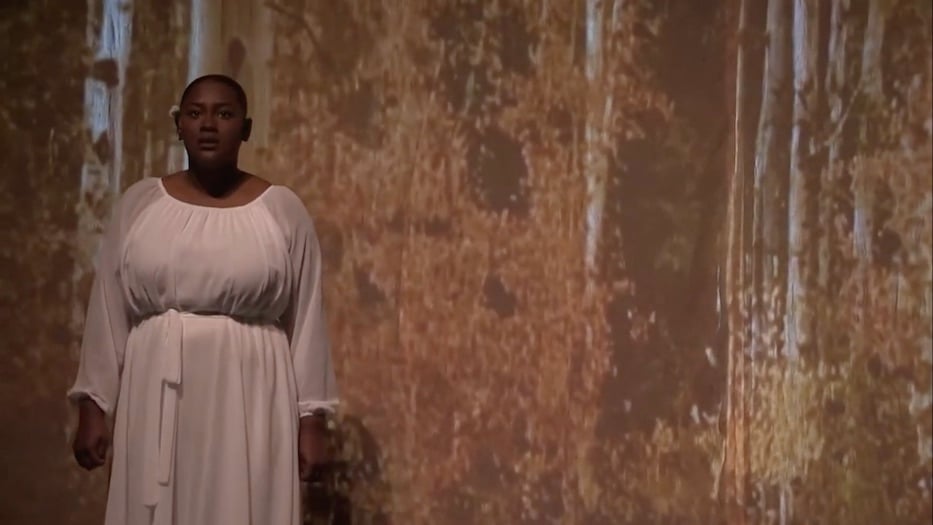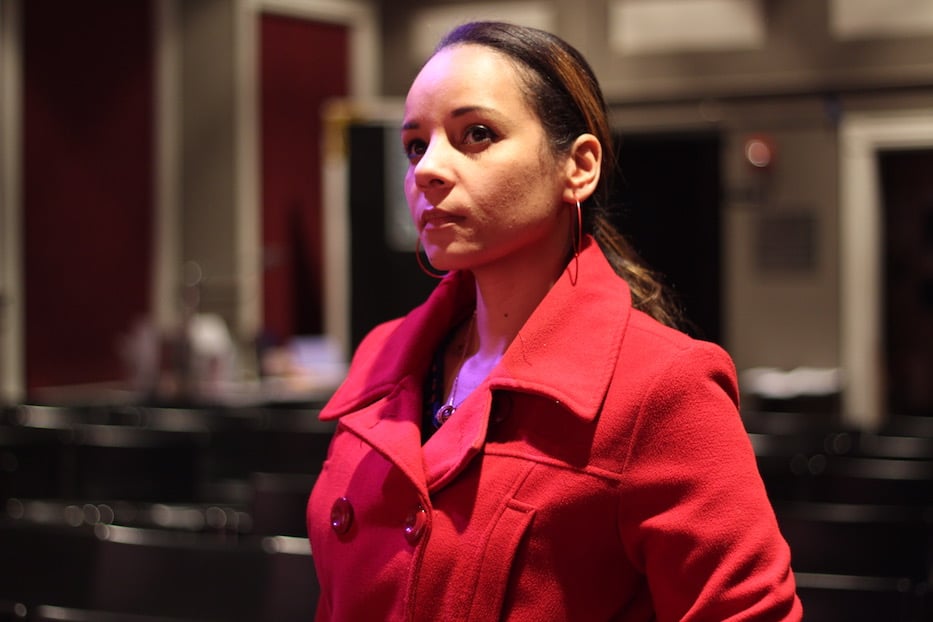
Poetry | Arts & Culture | Theater | Sharece Sellem | COVID-19 | Education

Vonnie Wilborn at filming at Normandale Community College. Screenshot from YouTube.
A woman walks through a carpet of leaves, the ground whispering beneath her feet. Her dress is bone-white as a burial shroud. As she speaks, she unspools the story of a corpse, left to rot on a riverbank for centuries. Her eyes gleam in the low light. In just over four minutes, she shoulders the weight of four centuries.
That tour de force is “The Ghost Of America’s Past,” a new choreopoem and video from New Haven playwright Sharece Sellem and Normandale Community College student Vonny Wilborn. This week, Sellem released the performance, which Wilborn recorded it in the fall of last year, virtually on her YouTube channel. The work addresses four centuries of white supremacy with a mix of history, sharp-tongued writing, and magical realism.
“This feels like a boogeyman in our closet,” Sellem said in a recent Zoom call. “It doesn’t go away. It’s like a ghost just lingering around. You can’t run away from it. Until we really address it. It’s like, you’ve gotta take that light and put it on the ghost and say, ‘Listen! We see you!’ We can’t move forward fully until everyone sees the ghost. Because we feel the ghost all day long. All day. Every day.”
In the choreopoem, Sellem personifies enslavement and white supremacy as a corpse, left to sink and fester in the same spot for hundreds of years. As it rots, passers by try to cover up the stench, their attempts purely cosmetic. A mother and daughter sprinkle flowers on it. The stink lingers. More flowers sprout, and then they die. Last fall, Wilborn brought it to life against a video backdrop of leaves and thick, dark woods populated with birch trees.
While there are plenty of references in the work—slave patrols, which were the origin of modern-day policing, the Four Horsemen of the Apocalypse, the bodies that populate the Danse Macabre, the shock of blood red poppies and the potter’s fields of the Civil War and of genocide—her voice rings clearly through the piece. It marks a departure from her pre-pandemic work, as if to say, I am tired. Are you tired, too?
Sellem wrote the piece in the fall, during the inaugural cohort of a playwriting group at Long Wharf Theatre. In the group, helmed by Steven Sapp and Mildred Ruiz-Sapp of UNIVERSES, she received a prompt to dig into what she was feeling in the moment. At the time, she said, she was in a sort of in-between place. She had just finished the New Haven Play Project. The Quick Quarantined Play Festival was on hold. Over the summer, she had watched Minneapolis police murder an unarmed Black man in broad daylight. An unending news cycle swirled around her.
“I found myself really being angry, and at the same time wanting to give a creative voice and visual representation of how I see the world in the past 400 years,” she said. “It’s really not only about George Floyd. It’s about 400 years. This is a long time issue. It’s an old issue. It’s a corpse.”
Hundreds of miles away in Minneapolis, Wilborn had never heard of Sellem’s work. She was midway through her fall semester in Normandale Community College’s theater department, and looking for a piece to perform for a filmed, socially distanced cabaret-style showcase. Her instructor Sean Byrd, who has mentored Wilborn since 2016, spotted the piece on New Play Exchange and brought it to her.
Wilborn, who is one of three Black students in the department, felt like she was reading a piece that had been written for her. For years, she has been advocating on behalf of herself and other actors and students of color for more diversity in the school’s theater program and on its stages. She recalled performing in six plays written by cisgender white men, none of whom has written her lived experience into their narratives.
This work, crafted by a Black woman in Connecticut, was immediately different. Her synapses crackled reading the words. A tingle traveled from her head to her toes, she said. She felt the same kind of fire she had over the summer, when she and her mother marched five miles from 38th Street and Chicago Avenue to the city’s third police precinct to mourn the state-sanctioned murder of George Floyd.
“I remember reading it, and I was like, ‘this is the one,’” she said. “When you read a piece as an artist, it’s no longer in your head. It fills your body. It’s not a thought. It’s not an idea. It’s just a feeling that you get. And it’s kind of indescribable, but I want to compare it to some sort of calling that you just feel.”
“I wasn’t around 400 years ago, but my spirit was,” she added. “The spirit of my people was. Reading pieces like that, that connect the past to the present … there’s just some sort of spiritual connection there.”
Wilborn practiced the work at home, as school remained on a hybrid schedule due to COVID-19. She worked with co-director Ashton Valentines, who is one of the only other students of color in the program. When she stepped in front of five white classmates in the auditorium, she said she felt a sense of power. It’s one she hopes to build on next semester, when she takes on Jireh Breon Holder’s Too Heavy For Your Pocket for her senior project.
For both her and Sellem, the work has continued to resonate precisely because it is steeped in history. While enslavement may have ended, the economic, emotional, and cultural subjugation of Black people has not. While Wilborn said she considers theater a sort of reprieve, she also struggles with the fact that she has to. She described herself as on a kind of autopilot: she wakes up, goes to work, comes home, practices her lines, goes to bed. Then she does it again.
“I have to protect my peace,” she said. “Going to work, or going to the grocery store, or going to the bank—it’s survival mode. It truly is survival mode. When I go to the store. It's making sure I get my receipt. Making sure I got my bag. Because I don’t want nobody to think I took anything. It’s just muscle memory at this point. It truly is just survival mode outside of the safety of our homes, our families, the relationships that we have with people of color.”

Sharece Sellem at a rehearsal for Dasies On Harlem's Doorstep in February 2020, just before COVID-19 hit Connecticut and shut down theaters. Lucy Gellman File Photo.
Sellem said that feeling echoes through her own life. Last week, she willed herself to walk away from the news cycle as fascists and Nazi sympathizers flooded the U.S. Capitol Building. On the television screen, she saw as white protesters, including one waving the Confederate flag, made it up the steps and into the building without violence from the police. She knew that Black protesters would not have made it nearly as far.
“This was representative to me of white parents coddling a misbehaving toddler,” she said. “You can’t even be safe at the Capitol. So why, why, would I ever feel safe? And why would any person of color, and most especially a Black person, ever feel safe? These people can go to the U.S. Capitol and do what they do?”
Sellem also identified the choreopoem as a piece of a much greater, long overdue conversation that she hopes to hear and see in the theater world going forward. Last June, she listened as organization after organization pledged a new commitment to diversity, equity, and inclusion. Very few of them, she said, included steps on how they planned to get there. She said she’d love to see more people of color on stage and in leadership, as well as more creative incubator programs led by and designed for people of color.
“Treat people as you would want to be treated. Period,” she said. “Just like we’re always performing your stories and supporting your plays, you need to be doing that for other people in your community who don’t look like you. That’s what needs to happen. It shouldn’t have to take a major world event. It shouldn’t have to take a George Floyd. It shouldn’t have to take any of that.”
“We need to tell everybody’s story,” Wilborn chimed in. “There’s room for everybody here. If you feel like you’re going to lose donors, or lose money, or you’re not going to get a great response, at that point, that’s not for you to worry about. That’s not for us to worry about as artists. We have to worry about getting the message out there.”

